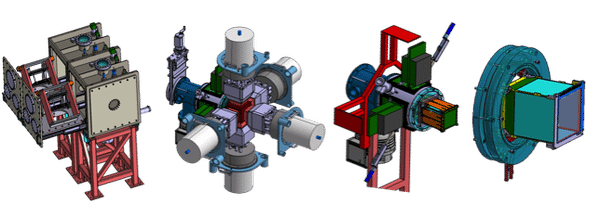- Homepage
- >
- Scientists
- >
- GANIL-SPIRAL 2 facilities
- >
- Instrumentation
- >
- SIRIUS
- Accelerators
- Available beams
- Experimental areas
- ARIBE
- D1
- D2
- D3-D6 / LISE
- D5
- DESIR
- G1 / VAMOS
- G2
- G3
- G4
- IRRSUD
- LIRAT
- NFS – Neutrons for Science
- S3 – Super Separator Spectrometer
- Instrumentation
- ACTAR TPC
- AGATA
- CHATEAU DE CRISTAL
- DIAMANT
- EXOGAM / EXOGAM2
- FAZIA
- INDRA
- LPCTrap
- MUST2
- NEDA
- PARIS
- REGLIS3
- S3 Low Energy Branch
- SIRIUS
SIRIUS
The objective of the SIRIUS project is to develop, commission and exploit a state-of-the-art focal plane detector system for decay spectroscopy. The focal plane system will be a complex device composed of variety of detectors in a compact geometry using new advanced technologies.
SIRIUS will be capable of detecting heavy ions and subsequent decays (alpha, conversion-electron, gamma, X-ray, beta and fission products) with energy and time resolutions that allow a clean identification of the rarest events. This will be done using the Recoil-Decay Tagging (RDT) method that correlates the time and position of the implanted ion with the time and position of its subsequent decays. It is also foreseen to use pulse shape analysis on the signals from the silicon detectors to enable the identification of the particle detected (i.e. electron, proton, alpha or heavy ion). Pulse-shape analysis to identify the detected particles has never been used in decay spectroscopy before and offers exciting possibilities. SIRIUS will be composed of a window-less highly segmented double-sided silicon strip detectors (DSSD) to detect the implantation of the produced nuclei as well as their decays. The energies of theses decays are measured with high resolution. The high kinetic energy (up to 500 MeV) of the recoiling nuclei and the low (from 2 MeV to 12 MeV) energy of their subsequent decays require a system with a large dynamic range for energy measurements. Events with short (down to 10 μs) as well as long (up to hours) time intervals between ion implantation and decay must be correctly correlated. The DSSD implantation detector will be surrounded by four new-generation Tunnel silicon detectors to measure charged particles (alpha particles, electrons and protons) escaping from the implantation silicon detector following the decay of the implanted ion. Germanium detectors in a close geometry around the implantation detector will be used for gamma-decay spectroscopy.

